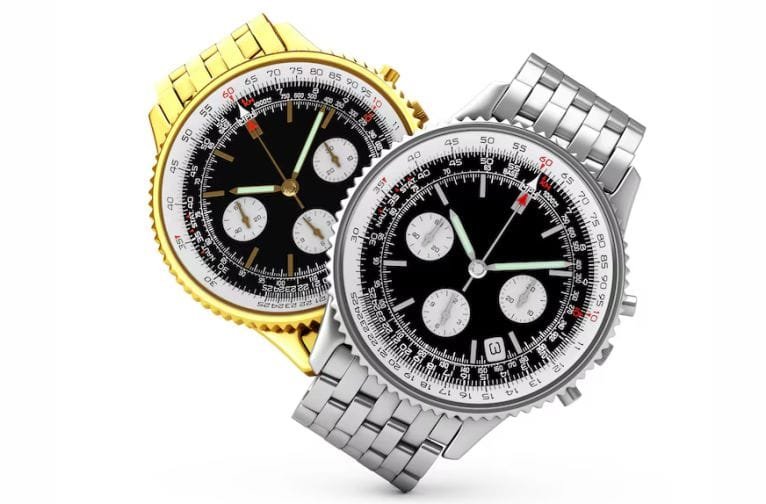Think that flashy timepiece is a steal? Think again. How to spot a fake watch reveals the subtle signs every man should know before making a costly mistake.
Luxury watches show status, craft, and personal taste for men. From Rolex to Patek Philippe, a quality watch does more than tell time: it reflects your image and can build long-term value.
But with demand comes risk. Counterfeit watches are getting harder to detect and often fool smart buyers.
You don’t want to waste your money on something that looks good but fails in quality and accuracy. Before you buy, you need to know what to check.
This guide helps you know how to spot a fake watch using real details: logo design, font accuracy, movement type, material weight, serial numbers, packaging, and seller credibility. Ask questions.
Check references. When in doubt, get it verified. A real watch gives you pride. A fake one gives you regret. Make your choice with care and confidence.
Related: Guide to Men’s Wristwatches
Table of Contents
- Know the Brand You’re Buying
- Examine the Logo and Lettering
- Inspect the Weight and Materials
- Check the Movement
- Examine the Case Back
- Inspect the Serial and Model Numbers
- Evaluate the Packaging and Paperwork
- Buy from Reputable Sources
- Use Professional Authentication Services
- Frequently Asked Questions
- Conclusion
Know the Brand You’re Buying
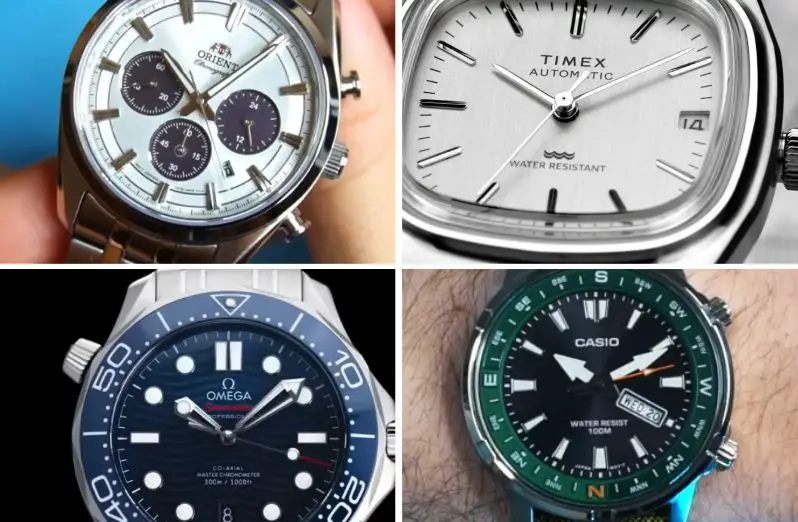
Being familiar with the brand you are buying is one way to know how to spot a fake watch.
Before spending thousands on a watch, get to know the brand. Don’t just rely on reviews or social media ads.
Go to the official website or trusted retailers. Look at the model you want and study its details: the shape of the hands, the size and placement of the date window, the feel of the dial, and the way the logo is printed.
These are details that counterfeit watches usually get wrong.
Learn the Brand’s Signature Details
Every watchmaker has details they stick to. Rolex watches have a cyclops lens that magnifies the date.
Cartier designs include Roman numerals and a smooth blue cabochon crown.
Omega, Tag Heuer, and Audemars Piguet also follow patterns in their dials, cases, and inscriptions.
When you know these features, spotting a fake becomes easier.
Study official product pages, compare images, and notice how real models are built.
The closer you look, the more obvious a fake becomes.
Be Smart About Pricing
Fake watches are often priced to tempt you into rushing.
A luxury watch listed far below its market value is almost always suspicious.
If someone offers you a $10,000 timepiece for $1,000, that’s a clear warning sign.
Brands like Rolex or Patek Philippe don’t allow such deep discounts through authorized sellers. Real deals have consistent pricing.
If the price feels off, pause and research. Trust isn’t built on urgency, and fakes rely on you not thinking twice.
Related Posts
- Accessories for Men: A Beginner’s Guide
- Dress Watches Guide for Gentlemen
- Curated Men’s Watches Under $100
- Luxury Men’s Watches Guide and Tips
- 7 Signs Your Watch Needs Maintenance
- How to Read a Watch
- What is Watch Complications?
- Men’s Casual Watches: What to Consider Before Buying
Examine the Logo and Lettering
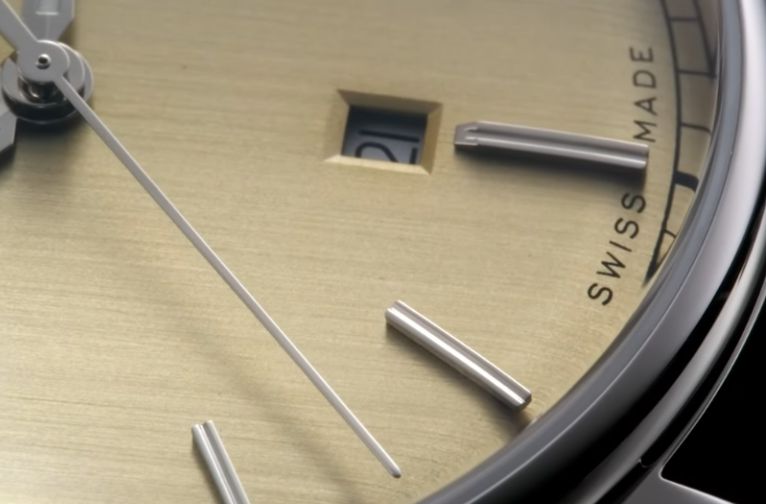
Another way to avoid buying a fake watch is to scrutinize the logo and lettering.
Logos and lettering are often the quickest way to tell if a watch is real or fake.
Luxury watch brands use specific fonts, spacing, and placements.
Everything is aligned with precision.
A logo that’s slightly off-center, stretched, or too bold should raise concern.
Always compare the logo with one from the official site or a trusted seller.
If it doesn’t match exactly, there’s a good chance the watch isn’t genuine.
Check for Spelling and Engraving Mistakes
Luxury watchmakers don’t make spelling errors. If you spot a typo like “Oister” instead of “Oyster” or see uneven lettering, walk away.
Brands like Rolex, Omega, and Cartier invest in quality craftsmanship.
A misspelled name or misaligned text is a clear red flag. You may also notice strange spacing or fonts that look slightly off.
These signs matter. No luxury brand would let such flaws pass quality checks. Trust your eyes and double-check everything.
Inspect the Etching Quality
High-end watches have clean, sharp engravings. Run your finger across the back or side of the case. Real watches feel smooth, with deep but refined cuts.
Fakes may feel shallow or rough. The letters might be blurry, uneven, or smudged, especially if the seller is trying to imitate details like the case number or logo.
Use a magnifier or your phone’s zoom to check. Poor engraving usually means a fake. Don’t ignore this.
Precision always reveals the truth.
Related: Men’s Watches Below $1000
Inspect the Weight and Materials
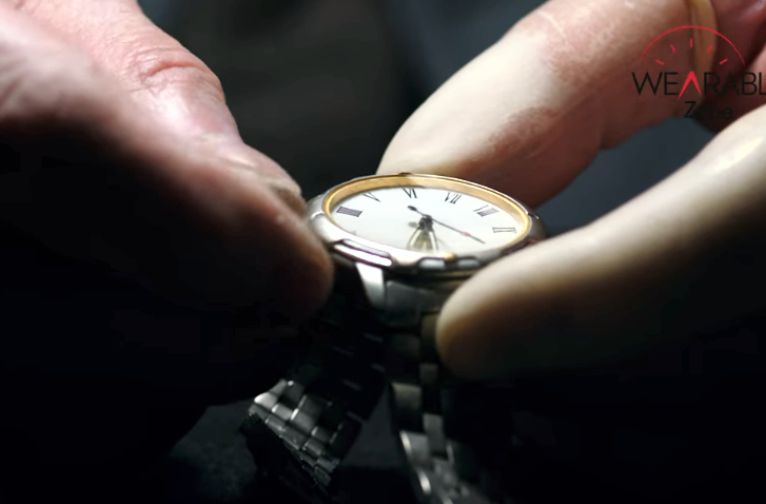
Knowing how to spot a fake watch includes inspecting the weight and materials.
The weight of a watch says a lot. Real luxury watches feel solid in your hand because they’re made with quality metals like stainless steel, gold, or titanium.
Fakes cut corners by using lightweight alloys or aluminum. When you pick up a watch and it feels too light or hollow, that’s a warning sign.
Authentic timepieces carry a balanced, dense feel. If it doesn’t feel right from the start, it probably isn’t.
Feel the Finish
Run your fingers across the watch. A genuine watch feels smooth with no sharp edges.
Luxury brands take pride in their finish, edges are rounded, surfaces are polished, and the shine is consistent.
Fake watches often have rough spots or patchy polishing. The case may feel gritty or the bracelet stiff.
You don’t need special tools for this—just your touch. If it doesn’t feel refined or balanced, there’s a strong chance it’s not authentic.
Examine the Material Quality
Don’t overlook the material. A real luxury watch won’t look or feel cheap. High-end watches use real stainless steel or precious metals.
Counterfeits can appear shiny at first glance but feel like plastic or low-grade metal when touched.
The bracelet might squeak or flex awkwardly. If you’re unsure, compare it with a known authentic model.
Quality materials stand out. A flimsy band or thin case tells you the watch isn’t built to last, and likely isn’t real.
Related: The Psychology of Watch: What Your Watch Says About You
Check the Movement
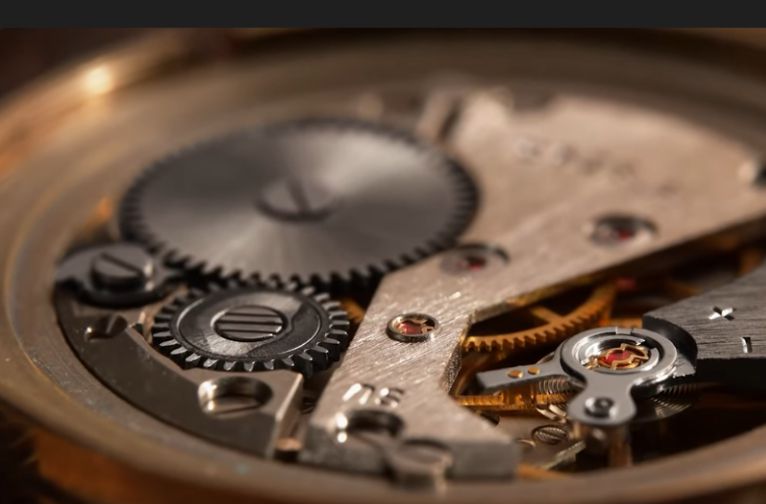
The movement powers the watch and reveals its quality. Before you buy, find out what type of movement the model should have: automatic, mechanical, or quartz.
Most Rolex models, for example, use automatic movements. If you hear ticking in a watch that’s supposed to be automatic, that’s a bad sign.
Fake watches often hide cheap quartz movements inside. Knowing what to expect from the brand helps you avoid getting fooled by a look-alike.
Listen to the Ticking
Put the watch close to your ear. Real automatic or mechanical watches tick smoothly and quietly.
Cheap replicas with quartz movements tick loudly or unevenly. The sound should match the level of craftsmanship you expect from a luxury watch.
If it’s loud or sounds like a wall clock, step back. You don’t need to be an expert, your ear will catch what feels off.
Trust what you hear; sound can be a simple but powerful test.
Look Through the Case Back
If the watch has a transparent case back, take a look inside. Genuine luxury watches have polished components and engraved details you can admire.
Everything inside should be clean, precise, and well-built.
Fakes usually show clunky, plastic, or rough parts with no attention to detail.
You might see parts that don’t even belong in that model. A clear view of the movement is like a window into the watchmaker’s skill, or lack of it, in the case of fakes.
Examine the Case Back
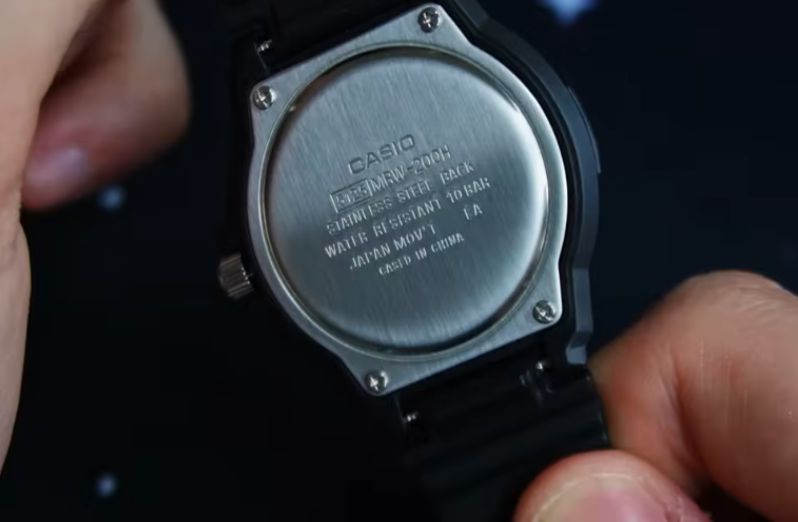
Don’t skip the case back, it can tell you more than the dial. Many fakes mess up this detail with sloppy parts, wrong engravings, or low-quality construction.
Watch Out for Wrong Engravings
Real luxury watches are specific about case back markings. Brands like Patek Philippe or Vacheron Constantin don’t use random phrases like “Limited Edition” without purpose.
Fakes try to impress with bold claims, but these aren’t consistent with the real model.
Look at the official version and compare. If the font, logo placement, or phrasing looks off, walk away.
Authentic case backs are subtle and precise, not overdone or full of generic stamps. Less is usually more when it’s real.
Check the Case Back Fit and Finish
Run your fingers along the case’s back edges. Feel how it’s fitted.
Luxury watches use screws or tight snap designs that align perfectly and feel solid.
Counterfeits may have flimsy screws, poor alignment, or loose backs. Look for polish and balance; the case back should feel as refined as the rest of the watch.
If you spot gaps, rough spots, or cheap materials, it’s likely fake. A rushed finish is a red flag. Quality shows even on the back.
Inspect the Serial and Model Numbers
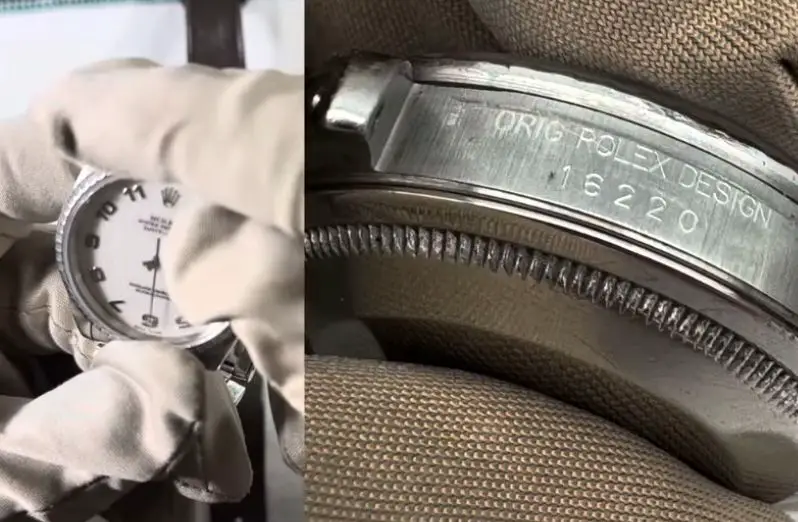
Checking the serial and model numbers is one of the best ways to confirm if a watch is real.
These numbers are unique to every authentic luxury watch and act as an ID.
You’ll usually find them engraved on the case, between the lugs, or on the case back.
Make sure the numbers match the paperwork that comes with the watch.
How to Verify the Numbers
Look closely at the engraving. Authentic watches have deep, clean markings. If the numbers are missing, shallow, or look rushed, that’s a warning sign.
Check the format of the serial and model numbers on the brand’s official site or trusted databases.
For example, Rolex serial numbers follow a specific pattern that changes by year, fakes often get this wrong.
Confirm with the Manufacturer or Dealer
If you can, reach out to the watchmaker or an authorized dealer to verify the numbers.
A missing or mismatched serial number almost always means the watch is fake. Brands keep these details precise and traceable to protect buyers like you.
Don’t skip this step; trust the numbers to guide your decision.
Evaluate the Packaging and Paperwork
When you buy a luxury watch, the packaging and paperwork tell a lot about its authenticity.
Real watches come in well-made boxes with sharp printing and sturdy materials.
Check for details like the logo quality and design, they should match what you see on the brand’s official site.
Flimsy boxes or blurry logos are warning signs.
Check the Warranty Card and Manual
Look closely at the paperwork. The warranty card and manual must match the watch’s model and serial numbers.
Authentic documents have clear text with no spelling mistakes.
Fake watches might come with generic manuals or cards that don’t line up with the watch details.
Trust What You See and Feel
If the box or papers feel cheap or don’t match what the brand usually offers, it’s likely a fake. Use packaging and paperwork to help you decide before you buy.
Buy from Reputable Sources
Where you buy your luxury watch matters as much as how you check it.
Stick to authorized dealers, certified retailers, or trusted online stores to lower the chance of getting a fake.
Authorized sellers know their products and usually offer warranties and support after your purchase.
Avoid Risky Marketplaces
Sites like eBay or Craigslist can be tricky. Listings might be unclear, and private sellers often have no return policy.
Always check seller reviews, ratings, and return terms before you buy.
A reliable seller will answer your questions clearly and won’t rush you into buying.
Ask for Proof When Buying Used
If you buy from someone directly, ask for clear photos, original receipts, and paperwork to confirm the watch’s authenticity.
Be careful of deals that look too good or sellers who avoid giving details.
A trustworthy seller will back their watch and make you feel confident in your purchase.
Use Professional Authentication Services
When you’re spending a lot on a luxury watch, getting it professionally checked can save you from costly mistakes.
A certified watchmaker or horologist can inspect the watch’s movement, parts, and build quality to confirm if it’s real.
They spot issues that you might miss, like wrong movement components or low-quality materials.
Why Authentication Matters for Vintage and Used Watches
If you’re buying vintage or pre-owned, wear and tear can hide signs of a fake.
Professional services provide detailed reports on the watch’s condition and authenticity. This helps you understand exactly what you’re getting.
How to Use Authentication Services
Before you buy, especially from someone you don’t know, consider sending the watch to an expert for verification.
This step adds a layer of trust and protects your investment.
Frequently Asked Questions
How can I tell if a watch’s logo is fake?
Check the font, spacing, and alignment against the official brand. Any uneven, blurry, or off-center logos are red flags for counterfeit watches.
Why does a watch’s weight matter when spotting a fake?
Authentic luxury watches use quality metals, so they feel solid. If a watch feels too light or hollow, it’s likely made from cheap materials.
Can the ticking sound reveal if a watch is real?
Yes. Genuine automatic watches tick smoothly and quietly. Loud, uneven ticking usually means a cheap quartz movement inside a fake watch.
Should I trust a very low price on a luxury watch?
No. Deep discounts on high-end watches are rare. Prices far below market value are often a sign of a fake or scam.
Conclusion
Knowing how to spot a fake watch is important so you don’t get scammed.
Buying a men’s luxury watch takes care and attention. Knowing the brand’s details, checking logos, engravings, and weight, and listening for smooth ticking all help you avoid fakes.
Pay close attention to serial numbers, paperwork, and packaging. Always buy from trusted sellers and consider professional authentication, especially for vintage or pre-owned watches.
Don’t rush just because the price seems too good to be true.
With these steps, you protect your investment and make sure your watch reflects your style and your standards.
Choose wisely and wear your watch with confidence.\
References
- How to Spot a Fake Rolex
- 3 telltale signs of a fake luxury watch, according to a watch authenticator
- How to Spot a Fake Rolex in 5 Minutes
Pyo Merez is a men’s lifestyle enthusiast and writer about the gentleman’s place and impact on society. Raised by a distinguished gentleman dad, he offers unique insights into how the mind of a gentleman works and how societal norms shape gentlemen’s identity and vice versa.
Through his insightful articles, Pyo taps into the depths of gentleman culture to provide perspectives on etiquette and manners in modern society.
